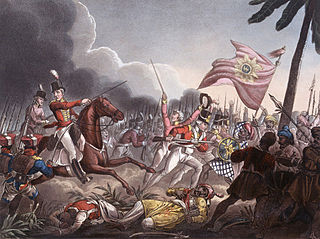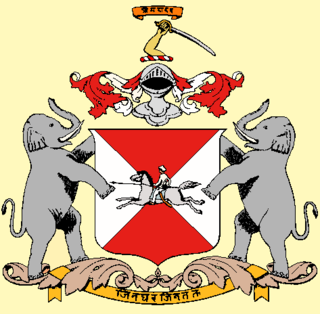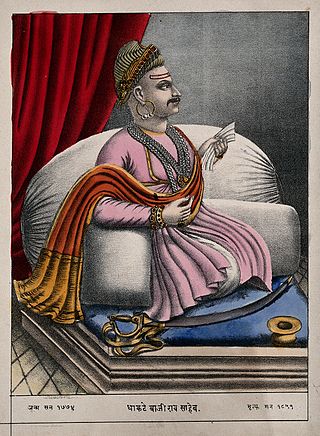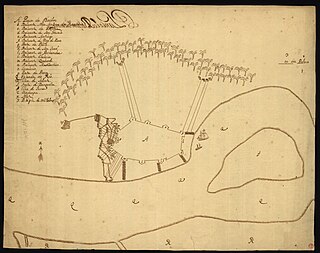
The Second Anglo-Maratha War was a large conflict within the Maratha Confederacy involving the British East India Company. It resulted in major loss of territory for the Marathas, including regions around Delhi and in present-day Gujarat falling into direct Company rule.

House of Scindia or earlier known as the Sendrak was a Hindu Maratha Royal House that ruled the erstwhile Gwalior State in central India. It had the Patil-ship of Kanherkhed in the district of Satara and was founded by Ranoji Scindia, who was sardar of maratha empire and real maratha warrior clan appointed by chattrapati shahuji maharaj-1's servant family from kokan worked as prime minister also known as Peshwa Bajirao I. Ranoji and his descendants, along with their rivals the Holkars, played a leading role during the Maratha ascendancy in northern India in the 18th-century. The Gwalior State became a princely state during the British Raj in the 19th and the 20th-centuries. After India's independence in 1947 and the abolition of princely states, several members of the Scindia Dynasty went on to enter Indian politics.

Gaekwads, a Hindu Maratha dynasty of the former Maratha Confederacy and its subsequent (erstwhile) princely state of Baroda in western India from the early 18th century until 1947. The ruling prince was known as the Maharaja Gaekwad of Baroda. With the city of Baroda (Vadodara) as its capital, during the British Raj its relations with the British were managed by the Baroda Residency. It was one of the largest and wealthiest princely states existing alongside British India, with wealth coming from the lucrative cotton business as well as rice, wheat and sugar production.

Madhavrao Jiwajirao Scindia was an Indian politician and minister in the Government of India. He was a member of the Indian National Congress. He was viewed as a potential future prime ministerial candidate before the 1999 Lok Sabha elections in the aftermath of the controversy over Sonia Gandhi's foreign origin.

Sir George Jiwajirao Scindia KStJ was the ruler of the Gwalior state during the British Raj and later the Rajpramukh (Governor) of the Indian state of Madhya Bharat.

Baji Rao II was the 13th and the last Peshwa of the Maratha Confederacy. He governed from 1795 to 1818. He was installed as a puppet ruler by the Maratha nobles, whose growing power prompted him to flee his capital Poona and sign the Treaty of Bassein (1802) with the British. This resulted in the Second Anglo-Maratha War (1803–1805), in which the British emerged victorious and re-installed him as the titular Peshwa. In 1817, Baji Rao II joined the Third Anglo-Maratha War against the British, after they favoured the Gaekwad nobles in a revenue-sharing dispute. After suffering several battle defeats, the Peshwa surrendered to the British, and agreed to retire in return for an estate at Bithoor and an annual pension.

The Scindia School is a private boarding school for boys, established in 1897, and situated in the historic Gwalior Fort, in the city of Gwalior. It was originally started exclusively for royals and nobles of Indian princely states, particularly the Marathas, though now it is available to every class. In 2010, the school enrolled 606 students, with a teacher:student ratio of 1:12.

The Battle of Vasai or the Battle of Bassein was fought between the Marathas and the Portuguese rulers of Vasai, a town near Mumbai (Bombay) in the Konkan region of the present-day state of Maharashtra, India. The Marathas were led by Chimaji Appa, a brother of Peshwa Baji Rao I.

Malhar Rao Holkar was a noble subedar of the Maratha Empire, in present-day India. He was one of the early officers along with Ranoji Scindia to help spread the Maratha rule to northern states and was given the estate of Indore to rule by the [chhatrapati's Pradhan, during the reign of the Maratha emperor Shahu I. He was founder of the Holkar dynasty that ruled Malwa.

Jayajirao Scindia GCB, GCSI, CIE of the Scindia dynasty of Maratha Confederacy was the last independent ruling Maharaja of Gwalior State during the British rule from 1843 to 1886.

The Gwalior State was a state within the Maratha Confederacy located in Central India. It was ruled by the House of Scindia, a Hindu Maratha dynasty. Following the dissolution of the Confederacy, it became part of the Central India Agency of the Indian Empire under British protection.

Daulat Rao Scindia also conferred with the title "The defender of Delhi" was the Maratha Maharaja of Gwalior state in central India from 1794 until his death in 1827. His reign coincided with struggles for supremacy within the Maratha Empire, and wars with the expanding East India Company. Daulatrao played a significant role in the Second and Third Anglo-Maratha wars. While most Indian rulers had accepted British rule, Scindia's kingdom maintained its independence even as late as 1832 and continued collecting Chauth (taxes) from other neighbouring states and dependent Kingdoms till 1886. As per an answer given by Mill in a Parliamentary Committee in Britain on February 16, 1832, on the status of Scindia's kingdom it was mentioned that “he was independent.” This Committee finally reported to Parliament that “within the Peninsula, Sindhia is the only prince who preserves the semblance of independence.”

Ranoji Scindia was the founder of the Scindia dynasty, a gifted military commander under whose leadership Malwa was conquered. Scindia dynasty rose to prominence in the 18th century and went on to dominate India as one of the most prominent powers due to their influential presence in Delhi and their highly modernised army.

Maharaja Sir Madhorao Scindia I of Gwalior, was the 6th Maharaja of Gwalior belonging to the Scindia dynasty of the Marathas.

The Great Maratha is an Indian historical drama television series directed by Sanjay Khan and produced by Numero Uno International Limited. The drama aired on DD National. The series is based on the life of Mahadaji Shinde. The show comprised 47 episodes. The music was composed by Mohammed Zahur Khayyam.
Kadarji Rao Scindia was the fourth Maharaja of Gwalior State for a brief period. He became Maharaja of Gwalior after two years of death of Jankoji Rao Scindia in Third battle of Panipat in 1761.
Amrut Rao was a Maratha noble, and the adopted son of Peshwa Raghunath Rao. In 1803, Yashwant Rao Holkar invaded Pune and deposed his adoptive brother Peshwa Baji Rao II. Subsequently, Holkar set up an ad hoc council nominally headed by Amrut Rao, and ran the Peshwa's government in his name. Holkar also installed Amrut Rao's son Vinayak Rao as the Peshwa to strengthen the legal status of his government, because Vinayak had been adopted by the widow of the deceased Peshwa Madhav Rao II. However, Baji Rao sought assistance from the British East India Company, whose advance forced Amrut Rao and his son to flee Pune. Subsequently, Amrut Rao signed a treaty with the British, agreeing to give up all claims over the Peshwa's office in return for a pension and an estate in Bundelkhand.
Colaba State, also known as Culaba State or Angria's Colaba was a Kingdom and later princely state in India. It was founded by the famous Maratha Navy admiral Kanhoji Angre in 1698. The ruling family of the state, the Angre, were skilled seafarers who controlled the western coast of India from the late 17th century- to the first half of the 18th century, until the Maratha Peshwa Balaji Baji Rao destroyed the major portion of their navy in the Battle of Vijaydurg.
Yesaji Angre was a military commander and the youngest son of Kanhoji Angre, the famed Maratha Navy admiral from his wife Gahinabai Bhonsle. He spent his naval career under the service of his elder half-brother Sambhaji Angre. The Gwalior branch of the Angre family was descended from him.














